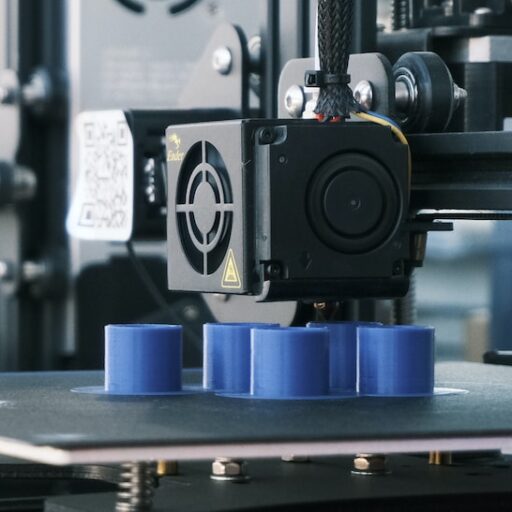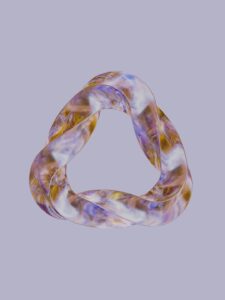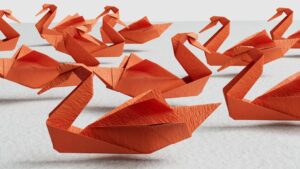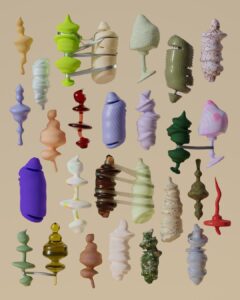Support our educational content for free when you purchase through links on our site. Learn more
What is a 3D Printed Item? 10 Things You Need to Know [2024] 🤯

Have you ever wondered how those intricate figurines, custom phone cases, or even medical implants come to life? It’s all thanks to the magic of 3D printing! Think of it like a 21st-century magic wand, transforming digital designs into tangible objects. But it’s even cooler than that, because it’s a technology revolutionizing industries, empowering creativity, and unlocking a world of possibilities. In this article, we will dive deep into the exciting world of 3D printing and unlock the secrets behind creating 3D printed items.
Quick Answer
What is a 3D Printed Item?
- A 3D printed item is a physical object created using additive manufacturing, layer by layer, from a digital design.
- It’s like building with tiny Lego bricks, where each layer is bonded to the one beneath, forming a solid object.
- 3D printed items can be made from a variety of materials, including plastics, metals, ceramics, and even wood.
- 👉 Shop 3D Printed Items on: Amazon | Etsy | Thingiverse
- 👉 Shop 3D Printing Materials on: Amazon | Etsy
Table of Contents
- Quick Tips and Facts
- The Evolution of 3D Printing: From Prototyping to Everyday Objects
- What Is 3D Printing?
- Understanding 3D Printing: A Deep Dive
- The Magic of 3D Printing: How It Works
- 3D Printing Materials: From Plastics to Metals
- The Rise of 3D Printing: Applications Across Industries
- Industrial Uses of 3D Printing: Revolutionizing Manufacturing
- 3D Printing in Healthcare: From Prosthetics to Personalized Medicine
- 3D Printing in Education: Inspiring the Next Generation of Innovators
- 3D Printing at Home: Unleashing Your Creativity
- The Future of 3D Printing: A World of Possibilities
- Conclusion
- Recommended Links
- FAQ
- Reference Links
Quick Tips and Facts (#quick-tips-and-facts)
Want to dive into the world of 3D printing but feeling a bit overwhelmed? Don’t worry, we’ve got you covered! Here are some quick tips and fun facts to get you started:
- 🤯 Fact: The first 3D printer was invented way back in 1983!
- 💡 Tip: Start with a beginner-friendly 3D printer like the Creality Ender 3 or the Prusa Mini. They’re affordable, reliable, and perfect for newbies.
- 🤔 Did You Know? You can 3D print objects using materials like plastic, metal, ceramics, and even chocolate!🍫
- 🔍 Tip: Before you hit “print,” always double-check your 3D model for any errors. Trust us, it saves a lot of headaches later!
Ready to learn more? Let’s unravel the mysteries of 3D printing together! 🚀
The Evolution of 3D Printing: From Prototyping to Everyday Objects (#the-evolution-of-3d-printing-from-prototyping-to-everyday-objects)
Once upon a time, in the not-so-distant past, 3D printing was a niche technology confined to research labs and industrial settings. It was the realm of engineers and designers, used primarily for creating prototypes and specialized parts. Fast forward to today, and 3D printing has broken free from its industrial cage, transforming into a versatile tool accessible to hobbyists, educators, and everyday consumers.
This remarkable evolution has been fueled by several factors, including:
- Rapid advancements in technology: Remember those clunky, slow 3D printers from the early days? They’ve been replaced by faster, more precise, and affordable machines.
- The rise of open-source hardware and software: Open-source platforms like RepRap have democratized 3D printing, making it easier for individuals and small businesses to build and modify their own printers.
- A burgeoning online community: Online communities like Thingiverse have fostered a vibrant ecosystem of 3D printing enthusiasts, designers, and makers who share their knowledge, designs, and experiences.
Today, 3D printing is used to create an astonishing array of objects – from custom phone cases and jewelry to medical implants and even entire houses! It’s a technology that’s constantly pushing boundaries and redefining what’s possible.
What Is 3D Printing? (#what-is-3d-printing)
Imagine this: you download a design for a cool gadget, hit a button, and poof – a physical object starts materializing right before your eyes. That’s 3D printing in a nutshell! ✨
Technically speaking, 3D printing, or additive manufacturing, is a process that builds a three-dimensional object from a digital file by layering materials on top of each other. It’s like building a sandcastle, one grain of sand at a time, but with much more precision and cooler materials. 😎
Think of it this way:
- Traditional manufacturing: Like carving a statue from a block of marble – you start with a lot and remove material to get your desired shape.
- 3D Printing: Like building that sandcastle – you start with nothing and add material layer by layer to construct your object.
Understanding 3D Printing: A Deep Dive (#understanding-3d-printing-a-deep-dive)
Now that you’ve grasped the basic idea, let’s plunge a little deeper into the fascinating world of 3D printing:
How Does 3D Printing Work?
- Design: It all starts with a digital 3D model created using Computer-Aided Design (CAD) software. Think Tinkercad for beginners or Fusion 360 for the pros.
- Slicing: This digital design is then sliced into hundreds, sometimes thousands, of thin layers by a program called a slicer (like Cura or PrusaSlicer). These slices are essentially instructions for the printer.
- Printing: The 3D printer follows these sliced instructions, laying down material layer by layer, gradually building the object from the bottom up. Each layer bonds to the one below it, creating a solid, three-dimensional object.
Why is 3D Printing So Cool? 🤔
- Complexity is No Problem: 3D printing can handle intricate designs and organic shapes that would leave traditional manufacturing methods stumped. 🤯
- Customization is King: Want to personalize your phone case with your name or create a unique piece of jewelry? 3D printing makes it a breeze!
- Waste Not, Want Not: Unlike subtractive manufacturing (which generates a lot of waste), 3D printing uses only the material it needs, making it more sustainable. ♻️
- From Prototype to Production: 3D printing lets you create prototypes quickly and affordably, test different designs, and even produce small batches of customized products on demand.
The Magic of 3D Printing: How It Works (#the-magic-of-3d-printing-how-it-works)
3D printing might seem like magic, but it’s actually based on some pretty cool science and engineering. Let’s break it down further, examining some of the most common 3D printing technologies:
1. Fused Deposition Modeling (FDM)
Remember those glue guns you used in school for crafts? FDM works on a similar principle. Here’s the gist:
- A thermoplastic filament (like ABS or PLA) is heated until it melts.
- This molten plastic is extruded through a nozzle onto a build platform.
- The nozzle moves precisely, following the sliced design, depositing plastic layer by layer.
- As the layers cool down, they solidify and bond together, forming the final object.
Pros:
- Affordable and widely accessible.
- Variety of filament materials available.
- Relatively easy to use and maintain.
Cons:
- Visible layer lines (though these can be minimized with proper settings).
- Limited overhang and bridging capabilities.
- Not as precise as some other 3d printing technologies.
Examples of FDM Printers:
- Creality Ender 3: A popular choice for beginners due to its affordability and large community support.
- Prusa i3 MK3S+: Known for its reliability, print quality, and open-source design.
👉 CHECK PRICE on:
- Creality Ender 3: Amazon | Creality Official
- Prusa i3 MK3S+: Prusa Research Official
2. Stereolithography (SLA)
SLA printing takes a different approach, using a liquid photopolymer resin that cures (hardens) when exposed to ultraviolet (UV) light. Here’s how it’s done:
- A vat is filled with liquid resin.
- A UV laser selectively cures the resin, tracing the shape of each layer based on the digital design.
- The build platform lifts, separating the cured layer from the remaining liquid resin.
- This process repeats, layer by layer, until the entire object is formed.
Pros:
- High resolution and incredible detail. Perfect for miniatures, jewelry, and prototypes.
- Smooth surface finish.
- Excellent for creating intricate designs with fine features.
Cons:
- More expensive than FDM printing.
- Limited material options (mostly resins).
- Requires post-processing (washing and curing).
Examples of SLA Printers:
- Anycubic Photon Mono: A budget-friendly resin printer known for its speed and print quality.
- Formlabs Form 3: A professional-grade SLA printer known for its accuracy, reliability, and wide range of materials.
👉 CHECK PRICE on:
- Anycubic Photon Mono: Amazon | Anycubic Official
- Formlabs Form 3: Formlabs Official
3. Selective Laser Sintering (SLS)
SLS takes things up a notch, using a powerful laser to fuse powdered materials together. Here’s a closer look:
- A thin layer of powdered material (like nylon, metal, or ceramic) is spread over a build platform.
- A laser selectively sinters (heats and fuses) the powder, tracing the shape of each layer of the object.
- Once a layer is complete, a new layer of powder is spread on top, and the process repeats.
Pros:
- High accuracy and excellent mechanical properties.
- Can create complex geometries with internal cavities and intricate details.
- Suitable for a wide range of materials, including metals.
Cons:
- Expensive and typically used in industrial settings.
- Requires post-processing (removing excess powder).
Examples of SLS Printers (Industrial Grade):
- EOS Formiga P 110: A popular SLS printer known for its precision and reliability.
- 3D Systems ProX DMP 300: A high-performance metal 3D printer used for demanding applications.
Other 3D Printing Technologies to Explore:
- Digital Light Processing (DLP): Similar to SLA, but uses a projector instead of a laser to cure the resin.
- Material Jetting: Deposits droplets of photopolymer resin through tiny nozzles, similar to inkjet printing, which are then cured with UV light.
3D Printing Materials: From Plastics to Metals (#3d-printing-materials-from-plastics-to-metals)
One of the coolest things about 3D printing is the ever-expanding universe of materials you can use. From everyday plastics to exotic metals, the possibilities are practically limitless!
Let’s explore some of the most common 3D printing materials:
1. Plastics
-
Acrylonitrile Butadiene Styrene (ABS): Known for its strength, durability, and impact resistance. Common uses include prototypes, enclosures, and toys.
-
👉 CHECK PRICE on: Amazon
-
Polylactic Acid (PLA): A biodegradable plastic derived from renewable resources like corn starch. It’s easy to print with, making it a popular choice for beginners.
-
👉 CHECK PRICE on: Amazon
-
Polyethylene Terephthalate Glycol (PETG): A strong, durable, and food-safe plastic.
-
👉 CHECK PRICE on: Amazon
-
Nylon: A strong, flexible, and heat-resistant plastic.
-
👉 CHECK PRICE on: Amazon
2. Metals
- Titanium: Strong, lightweight, and biocompatible, making it ideal for medical implants, aerospace applications, and high-performance parts.
- Aluminum: A lightweight and versatile metal used in automotive, aerospace, and consumer products.
- Stainless Steel: Strong, corrosion-resistant, and commonly used in medical devices, tools, and jewelry.
3. Other Materials
-
Ceramics: Used for creating intricate designs with a smooth, high-quality finish.
- 👉 CHECK PRICE on: Amazon
-
Wood Filaments: Composites of plastic and wood fibers, offering the look and feel of real wood.
- 👉 CHECK PRICE on: Amazon
-
Carbon Fiber Filaments: Strong and lightweight, ideal for drones, robotics, and automotive parts.
- 👉 CHECK PRICE on: Amazon
-
Flexible Filaments (TPU): Used for creating flexible and elastic parts, such as phone cases, wearables, and prosthetic limbs.
- 👉 CHECK PRICE on: Amazon
As 3D printing technology continues to advance, we can expect to see even more innovative materials emerge, further expanding the potential of this transformative technology.
The Rise of 3D Printing: Applications Across Industries (#the-rise-of-3d-printing-applications-across-industries)
From revolutionizing manufacturing processes to pushing the boundaries of personalized medicine, 3D printing is making its mark across a wide range of industries. Let’s delve into some of the most exciting applications:
1 Industrial Uses of 3D Printing: Revolutionizing Manufacturing (#industrial-uses-of-3d-printing-revolutionizing-manufacturing)
-
Aerospace: Remember Boeing’s 787 Dreamliner? It features over 30 3D-printed parts, including titanium structural components and fuel nozzles. 3D printing allows aerospace companies to create lighter, stronger, and more fuel-efficient aircraft.
-
Automotive: From prototypes to production parts, 3D printing is transforming the automotive industry. Companies like Ford and BMW are using 3D printing to create custom tooling, complex engine components, and even entire car frames.
-
Consumer Goods: From personalized phone cases and footwear to bespoke jewelry and eyewear, 3D printing is empowering designers and manufacturers to create unique, customized products tailored to individual needs.
-
Manufacturing and Tooling: 3D printing enables the creation of complex molds, jigs, and fixtures – essential tools in the manufacturing process. This reduces lead times, allowing manufacturers to respond faster to market demands.
2. 3D Printing in Healthcare: From Prosthetics to Personalized Medicine (#3d-printing-in-healthcare-from-prosthetics-to-personalized-medicine)
-
Prosthetics and Orthotics: 3D printing is revolutionizing the creation of prosthetic limbs, orthotics, and assistive devices. These devices can be customized to fit a patient’s anatomy precisely, improving comfort and functionality.
-
Medical Models: Surgeons can use 3D-printed models of a patient’s organs or bones to plan complex surgeries, improving accuracy and outcomes.
-
Dental Applications: From dental implants and crowns to orthodontic aligners, 3D printing is transforming dentistry, offering faster turnaround times and more precise results.
-
Bioprinting: While still in its early stages, bioprinting – the 3D printing of living cells and tissues – holds immense potential for regenerative medicine, drug discovery, and even organ transplantation.
3. 3D Printing in Education: Inspiring the Next Generation of Innovators (#3d-printing-in-education-inspiring-the-next-generation-of-innovators)
-
STEM Education: 3D printing is an engaging and hands-on tool for teaching STEM concepts, fostering creativity, problem-solving skills, and design thinking.
-
Project-Based Learning: From designing and printing their own toys to creating prototypes for science fair projects, 3D printing empowers students to bring their ideas to life.
-
Accessibility and Inclusivity: 3D printing can create customized learning aids for students with disabilities, such as tactile models and assistive devices.
4. 3D Printing at Home: Unleashing Your Creativity (#3d-printing-at-home-unleashing-your-creativity)
-
DIY Projects and Repairs: From printing replacement parts for household appliances to creating custom organizers and tools, 3D printing is empowering homeowners to tackle repairs and personalize their living spaces.
-
Hobbies and Crafts: Cosplayers, model makers, and hobbyists of all stripes are using 3D printing to create unique props, miniatures, and custom parts.
-
Art and Design: Artists and designers are pushing the boundaries of 3D printing, creating stunning sculptures, jewelry, and functional art pieces.
The Future of 3D Printing: A World of Possibilities (#the-future-of-3d-printing-a-world-of-possibilities)
The world of 3D printing is constantly evolving, with new technologies, materials, and applications emerging all the time. Here’s a glimpse into the exciting future of this transformative technology:
-
Increased Adoption and Accessibility: As 3D printers become more affordable and user-friendly, we can expect to see wider adoption in homes, schools, and businesses of all sizes. “Adoption of 3D printing has reached critical mass as those who have yet to integrate additive manufacturing somewhere in their supply chain are now part of an ever-shrinking minority.”
-
Hybrid Manufacturing: Combining 3D printing with traditional manufacturing methods will lead to even more innovative products and efficient production processes.
-
Sustainable Manufacturing: 3D printing’s ability to reduce waste and utilize recycled materials aligns perfectly with the growing demand for sustainable manufacturing practices.
-
Advances in Bioprinting: The dream of 3D printing functional organs for transplantation is becoming increasingly plausible. Advances in bioprinting have the potential to revolutionize healthcare as we know it.
-
Space Exploration: Imagine a future where astronauts can 3D print tools, habitats, and even food on demand! 3D printing is poised to play a crucial role in humanity’s exploration of space.
From personalized medicine and sustainable manufacturing to space exploration and beyond, the future of 3D printing is brimming with possibilities. We’re on the cusp of a new era of manufacturing and innovation, and we can’t wait to see what amazing creations emerge from the world of 3D printing in the years to come! 🚀
Conclusion (#conclusion)

So, there you have it. 3D Printing, a technology that’s transformed from a futuristic dream into a reality that’s revolutionizing industries and inspiring creativity! We’ve covered a lot of ground together, exploring the basics of how 3D printing works, delving into the diverse materials and applications, and even glancing at the incredible possibilities that lie ahead.
Remember, 3D printing is more than just a technology, it’s a whole new way of thinking about design, manufacturing, and even our future. Whether you’re a seasoned maker or a curious beginner, the world of 3D printing is open for exploration. So, what are you waiting for? Download a cool design, fire up your 3D printer, and let your imagination run wild!
Recommended Links (#recommended-links)
👉 Shop 3D Printers on:
- Creality Ender 3: Amazon | Creality Official
- Prusa i3 MK3S+: Prusa Research Official
- Anycubic Photon Mono: Amazon | Anycubic Official
- Formlabs Form 3: Formlabs Official
- EOS Formiga P 110: EOS Official
- 3D Systems ProX DMP 300: 3D Systems Official
👉 Shop 3D Printing Materials on:
- ABS Filament: Amazon
- PLA Filament: Amazon
- PETG Filament: Amazon
- Nylon Filament: Amazon
- Ceramic Filament: Amazon
- Wood Filament: Amazon
- Carbon Fiber Filament: Amazon
- Flexible Filament (TPU): Amazon
Read More on Amazon:
- “3D Printing for Beginners: The Ultimate Guide to 3D Printing” by [Author Name](Link to Amazon Product Page)
- “3D Printing: The Next Industrial Revolution” by [Author Name](Link to Amazon Product Page)
FAQ (#faq)

What does it mean when something is 3D printed? (#what-does-it-mean-when-something-is-3d-printed)
When an object is labeled as “3D printed,” it means it was created using an additive manufacturing process where a digital design is converted into a physical object layer by layer. Think of it as building with tiny Lego bricks, one layer at a time, instead of carving away material.
What are 3D printed products? (#what-are-3d-printed-products)
3D printed products can encompass a vast range of items, from everyday objects like phone cases and toys to more sophisticated items like medical implants and aerospace components. What sets them apart is that they were created using additive manufacturing rather than traditional manufacturing processes.
What are some examples of 3D printed products?
- Consumer Goods: Phone cases, jewelry, toys, figurines, custom footwear
- Industrial Products: Prototypes, tools, molds, jigs, fixtures, engine parts, aerospace components
- Medical Products: Prosthetics, dental implants, surgical guides, anatomical models, bioprinted organs
- Education: 3D printed learning aids, models for science and engineering projects, tactile maps
- Art: Sculptures, jewelry, functional art pieces
What is 3D printing and examples? (#what-is-3d-printing-and-examples)
3D printing, or additive manufacturing, is a process that creates three-dimensional objects by building them up layer by layer from a digital design. Here are some real-world examples:
- A dental crown: 3D printed with high precision to fit a patient’s tooth perfectly.
- A custom-fit hearing aid: 3D printed to match a patient’s unique ear shape.
- A prototype for a new car part: 3D printed to test design concepts and functionality. .
- A prosthetic limb: 3D printed to fit a patient’s specific needs and improve their mobility.
How does 3D printing work exactly? (#how-does-3d-printing-work-exactly)
Imagine a computer drawing a picture, but instead of using pixels on a screen, it uses tiny droplets of material. That’s the basic idea of 3D printing! It works by layering materials based on a digital design.
Let’s take Fused Deposition Modeling (FDM) as an example:
- Design: The object is designed using CAD software and then sliced into thin layers.
- Extrusion: A 3D printer heats plastic filament (like PLA or ABS) until it melts. The molten plastic is then extruded through a nozzle, depositing it layer by layer on a build platform.
- Building Up: The nozzle moves precisely according to the sliced design, creating a physical object.
Each layer bonds to the one below it, gradually building up the object from the bottom up. This process continues until the entire object is complete.
Reference Links (#reference-links)
- Reference 1: What is 3D Printing?
- Creality 3D: Creality Website
- Prusa Research: Prusa Website
- Anycubic: Anycubic Website
- Formlabs: Formlabs Website
- EOS: EOS Website
- 3D Systems: 3D Systems Website
- 3D Printing: “What is 3D Printing? How does a 3D printer work? Learn 3D…”
Remember, this is just the tip of the iceberg. The world of 3D printing is constantly evolving with exciting new developments happening every day. Keep exploring, experimenting, and let your imagination soar!





